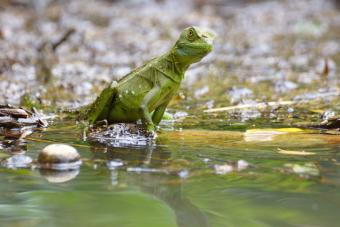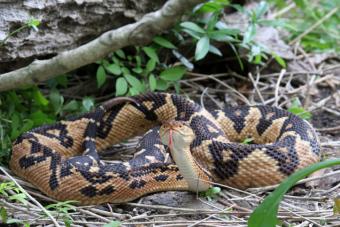
Due to the rich foliage and abundant sources of water, some of the world's most unique and interesting animals call the jungle their home. From primates and cats to fascinating reptiles and cartoonish birds, the jungle is teeming with animals for you to learn about.
Central and North America
From Mexico to Panama, animals in this area feature some of the most brightly colored, best documented and even most deadly in the world.
- Brazilian wandering spider - Often called 'banana spiders' because they are frequently found on banana leaves, these creatures are considered one of the deadliest spiders in the world. They are unique because they actively hunt to catch prey.
- Glass Frogs - This cool frog gets its name from having nearly translucent skin and a ventral side. They like to live in trees and are found largely in Central America, although you can find them in South America as well.
- Green Basilisk Lizard (Jesus Lizard) - The green basilisk lizard, or Jesus lizard, is so named because it can run on water. It does this by unfurling fringes on its back legs that increase the surface area of the water in combination with using its great speed.

- Jaguars - Jaguars can be found in a variety of habitats including the jungles of Central and South America. They are incredibly good at hunting, and their bodies are designed to kill prey. They have a rough tongue for peeling back skin, and loose belly skin so they can get kicked by prey but not be injured. Stay far away from these cats.
- Quetzals - The quetzal is a colorful bird with an iridescent green body and tail feathers that are as long as his body. They are incredibly colorful and are featured often in the folklore of Central America. The Quetzal is so widely revered that it is actually on the Guatemalan flag.

- Spectacled Caiman - The spectacled caiman makes its home in Mexico and other jungles in Central America. It gets its name from a bony ridge that sits in between its eyes that makes it look like its wearing glasses.
- White-nosed Coati - The coati has a long snout for foraging and a semi-prehensile tale that it typically holds straight up above its body.
South America
Monkeys, butterflies and more - the Amazon jungle alone hosts more than two thousand different species of animals.
- Bushmaster - The bushmaster is a pit viper that lives on the floors of the jungles in Costa Rica. It uses 'pits' behind its eyes and nostrils to smell prey and may lie in wait for weeks to ambush prey along popular routes.

- Black Spider Monkey - The black spider monkey can be found in the western jungles of South America. They are one of seven species of spider monkeys that live in South America, and they can use their tail as a third 'leg' to help balance while standing on branches.
- Blue Morpho Butterfly - These giant blue butterflies can have a wing-span of up to eight inches. While the outside of their wings have scales that reflect light to give them their bright blue color, the undersides are camouflaged brown with spots. When they fly, it looks like they are appearing and disappearing.
- Decoy Building Spider - Found in Peru, these orb spiders use jungle 'trash' (like rotting leaves and other bug corpses) to build decoys of themselves in their webs to confuse predators.
- Green Anaconda - This jungle giant can grow up to 22 feet and weigh up to 550 pounds. Not surprisingly, the anaconda is the largest snake species in the world.
- Toothpick Fish - The Canidru fish, or toothpick fish, is a parasitic catfish. It is the feature character in a common myth that it likes to attach itself into the genitals of unsuspecting swimmers. That probably isn't true, but the canidru is transparent, making him very difficult for his hosts to see him before he latches on.
- Capybara - The capybara, like many rodents, is prolific, and you can find them throughout much of South America. They can grow up to two feet tall and don't exclusively live in the jungle, but they prefer to be near both water and grasslands. They bask in the water and mud during the day and move to the grasslands to graze at night.

Africa
This continent is home to a wide variety of climates, but the jungles are located primarily in the central part. They host a variety of animals and are especially known for being home to many of the world's primates.
- Baboons - Found mostly in Africa, these large monkey relatives can grow to be about 80 pounds, making them one of the biggest primates. Their most dangerous predators are humans.
- Bongos - One of the largest rainforest animals, Bongos are found in the jungles of Africa. They have long, spiral antlers that they use to help them navigate the jungle floor.

- Bonobos - Bonobos are a species of chimpanzee found only in the Democratic Republic of Congo, in the jungle areas near the Congo river. They communicate with human-like gestures and whimper if they do badly at something.
- Forest elephant - These gentle giants live in the tropical forests of the Congo. They are in danger of becoming extinct because they are heavily hunted for their ivory tusks.
- Lemurs - Lemurs are found in the jungles (as well as other habitats) of Madagascar and are the most endangered animal group on the planet. They are incredibly social and tend to live in groups of 30, called troops.
- Mandrills - Mandrills are notable for their long blue and red snouts. They sleep in trees, choosing a different spot each night, and they often store their food in large cheek pouches so they can take it to a safer place to eat.
- Okapis - What do you get when you cross a giraffe, a zebra, and a deer? An okapi! These animals are actually related to the giraffe and feature solid colored bodies with zebra-striped legs.

Asia-Pacific Region
From the jungles of Borneo, Java, and Sumatra to New Zealand, Australia and more, this area of the world features a tropical climate perfect for a variety of animals to live.
- Flying Foxes - Not really a fox at all, this fruit bat is one of four mega-bat species in Australia. They are a protected Australian species and are incredibly important for the ecosystem in which they live as they are efficient pollinators.
- Gibbons - Gibbons are arboreal primates (monkeys who live in trees) and are known both for their acrobatic skills and their singing that makes them easy to find. They are an endangered species due to a rapid loss of habitat.

- Griffin's Leaf-Nosed Bats - This funky-looking bat has a fleshy 'leaf-nose' that it uses to emit echolocation noises. You can find them in only two places on Vietnam, and the species wasn't discovered until 2012.
- Komodo Dragon - Looking like something straight from Jurassic Park, Komodo dragons are the largest living lizard in the world. They come in a variety of colors (including blue, orange, green and gray) and make their home in Komodo National Park across five islands.
- Malayan Tapirs - As the name suggests, these tapirs are usually found in the jungles of Malaysia. They are known for their half black, half white bodies, but when they are born, they feature a spotted coloring that is similar to a watermelon. The spots serve as camouflage.
- Orangutans - These primates are large, with reddish-brown hair. They share a distinctively close bond with their young and are known for being incredibly intelligent.
- Rhinoceros Hornbill - This black bird might look like it walked right out of a sci-fi movie. It features a prominent, yellow 'horn' on its bill, which is how it got its moniker. They nest by finding a hollow spot in a tree, and the female shuts herself in using fruit, mud, feces and other materials.

Jungle Animals of the World
Jungles and rainforests play home to almost 50 percent of the world species. Studying jungle animals is a great way to learn about the natural resources jungles offer as well as the biodiversity of interesting animals including insects, birds, reptiles, and mammals.







